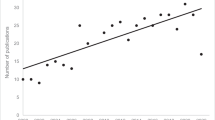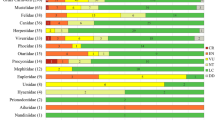Abstract
The bush cricket Saga pedo is a critically endangered species in the EU and is included in Annex IV of Council Directive 92/43/EEC. This species is therefore subject to mandatory regular monitoring within all member countries where it occurs. Because its abundance is low and little information is available concerning its ecology, however, an effective monitoring method that would yield standardized results has yet to be devised. We found S. pedo passing through 6 instars during its development in Central European conditions. Our findings indicate that, after hatching, S. pedo moves constantly through terrain with optimal vegetation and thereby reduces its population density. Based on recaptures of marked individuals, adults moved usually between 0.5 and 2 m in 24 h, the largest distance moved during a day was recorded as 37.5 m. Combined with a high mortality rate, this continual movement leads to very low density late in the season. Based on extensive surveys conducted during 2006–2011 at 10 sites in the Pálava Protected Landscape Area (Czech Republic), we show that the optimal time for monitoring in order to achieve comparable results from different investigators in different locations is the period just after nymphs hatch (1–10 May in Central Europe). Because S. pedo populations in Europe are threatened by habitat destruction resulting from successional overgrowth of habitat by vegetation and afforestation, ensuring the survival of this species will require that successional changes in vegetation and afforestation be stopped by mowing and removal of woody plants and seedlings or by farming (extensive grazing). Management need not be performed every year but should occur when the S. pedo population is already adult and dispersed. The most suitable period for partial machine mowing (1/3–1/2 of a specific area) is September. Mowing with scythes and extensive rotational grazing are the best methods for managing sites where S. pedo is found.


Similar content being viewed by others
References
Bailey RI, Lineham ME, Thomas CD, Butlin RK (2003) Measuring dispersal and detecting departures from a random walk model in a grasshopper hybrid zone. Ecol Entomol 28:129–138
Baur B, Baur H, Roesti C, Roesti D (2006) Die Heuschrecken der Schweiz. Haupt, Bern
Berg H-M, Zuna-Kratky T (1997) Heuschrecken und Fangschrecken. Eine Rote Liste der in der Niederösterreich gefährdeten Arten. NÖ Landesregierung, Wien
Cantrall IJ (1972) Saga pedo (Pallas) (Tettigoniidae: Saginae) an old world katydid new to Michigan. Gt Lakes Entomol 5:103–106
Dutrillaux AM, Lemonnier-Darcemont M, Darcemont Ch, Krpa V, Fouchet P, Dutrillaux B (2009) Origin of the complex karyotype of the polyploid parthenogenetic grasshopper Saga pedo (Orthoptera: Tettigoniidae). Eur J Entomol 106:477–483
Fontana P, Cussigh F (1996) Saga pedo (Pallas) ed Empusa fasciata Brulle in Italia, specie rare da proteggere. Atti Acc Rov Agiati 246(6):47–64
Gardiner T, Hill J, Chesmore D (2005) Review of the methods frequently used to estimate the abundance of Orthoptera in grassland ecosystems. J Insect Conserv 9:151
Gulička J (1954) Beitrag zur Kenntnis der Verbreitung einiger Orthopteren und Dermapteren in der Slowakei. Biológia (Bratislava) 9:617–630
Heller KG, von Helversen O (1990) Survival of a phaneropterid bush-cricket studied by a new marking technique (Orthoptera. Phaneropteridae). Entomol Gen 15:203–208
Holuša J, Kočárek P (2005) Orthoptera (rovnokřídlí). In: Farkač J, Král D, Škorpík M (eds) Červený seznam ohrožených druhů České republiky, Bezobratlí. Red list of threatened species in the Czech Republic, Invertebrates. Agentura ochrany přírody a krajiny ČR, Praha, pp 133–134
Holuša J, Kočárek P, Drozd P, Vlk R (2009) Analysis of population trend in Saga pedo (Orthoptera: Tettigoniidae) on the edge of its range: more abundant or more intensively studied? Metaleptea, special conference issue 29:120–121
Holuša J, Kočárek P, Vlk R (2010) Occurrence of Saga pedo (Orthoptera: Tettigoniidae) in the Czech Republic: review of faunistic data. North West J Zool 6:218–224
Holuša J, Kočárek P, Marhoul J, Skokanova H (2012) Platycleis vittata (Orthoptera: Tettigoniidae) in the northwestern part of its range is close to extinction: is this the result of landscape changes? J Insect Conserv 16:295–303
Ingrisch S, Köhler G (1998) Die Heuschrecken Mitteleuropas. Die Neue Brehm Bücherei 629. Westarp Wissenschaften, Magdeburg
Kaltenbach A (1967) Unterlagen für eine Monographie der Saginae 1. Superrevision der Gattung Saga Charpentier (Saltatoria: Tettigoniidae). Beitr Entomol (Berlin) 17:3–107
Kaltenbach A (1970) Unterlagen für eine Monographie der Saginae II. Beiträge zur Autökologie der Gattung Saga Charpentier (Saltatoria: Tettigoniidae). Zool Beitr 16:155–245
Kaltenbach AP (1990) The predatory Saginae. In: Bailey WJ, Rentz DCF (eds) The Tettigoniidae. Biology. Systematics and evolution. Springer, Berlin, pp 280–302
Kenyeres Z, Bauer N, Rácz I (2002) Saga pedo Pallas dans le bassin des Carpates, synthese et nouvelles données (Orthoptera. Tettigoniidae). Bull Soc Entomol Fr 107:149–156
Kindvall O (1999) Dispersal in a metapopulation of the bush cricket Metrioptera bicolor (Orthoptera: Tettigoniidae). J Anim Ecol 68:172–185
Kindvall O, Ahlen I (1992) Geometrical factors and metapopulation dynamics of the bush cricket Metrioptera bicolor Philippi (Orthoptera: Tettigoniidae). Conserv Biol 6:520–529
Kočárek P, Holuša J, Vidlička Ľ (2005) Blattaria. Mantodea. Orthoptera & Dermaptera of the Czech and Slovak Republics. Kabourek, Zlín
Kolics B, Nagy B, Kondorosy E, Puskás G, Müller T (2008) The life cycle of Saga pedo Pallas 1771 and its distribution in Hungary. Állattani Közlemények 93(1):39–52
Krištín A (2001) Red list of Orthoptera of Slovakia. Ochrana Prírody (Suppl.) 20:103–104
Krištín A, Kaňuch P (2006) Grasshoppers and crickets (Orthoptera) and mantids (Mantodea) of the Zoborské vrchy Mts. area (W Slovakia). Rosalia 18:99–108
Krištín A, Kaňuch P (2007) Population, ecology and morphology of Saga pedo (Orthoptera: Tettigoniidae) at the northern limit of its distribution. Eur J Entomol 104:73–79
Krištín A, Kaňuch P, Puchala P (2005) Orthopteroid insects (Orthoptera s. l.) of the Malé Karpaty Mts. (W Slovakia). Ochrana Prírody 24:56–66
Lemonnier-Darcemont M, Bernier Ch, Darcemont Ch (2009) Field and breeding data on the European species of the genus Saga (Orthoptera: Tettigoniidae). Articulata 24(1/2):1–14
Nagy B, Kis B, Nagy L (1984) Saga pedo Pall. (Orthoptera. Tettigoniidae): verbreitung und ökologische Regelmässigkeiten des Vorkommens in SO-Mitteleuropa. Verh SIEEC X Budapest 1983:190–192
New TR (1998) Invertebrate Surveys for Conservation. Oxford University Press, Oxford
Oláh M (1987) A new occurrence of the Saw-legged grasshopper Saga pedo (Pall.) in the Mátra Mts. Fol Hist Nat Mus Matr 12:43–45
Redtenbacher J (1900) Die Dermatopteren und Orthopteren (Ohrwürmer und Geradflügler) von Österreich-Ungarn und Deutschland. C. Gerolds Sohn, Wien
Samietz J, Berger U (1997) Evaluation of movement parameters in insects—bias and robustness with regard to numbers. Oecologia 110:40–49
Schall A (2002) Details on the knowledge of Saga pedo (Pallas. 1771), biological cycle in captivity (Orthoptera. Tettigoniidae. Saginae). Bull Soc Entomol Fr 107:157–164
Vidlička L, Janský V, Fedor PJ, Krumpál M, Lukáš J (2002) Distribution of Saga pedo in Slovakia. Articulata 17:95–100
Vrabec V, Kočárek P (2005) The observation of Saga hellenica Kaltenbach, 1967 (Orthoptera) on Corfu island. Entomofauna Carpathica 17:11–13
Willemse L (1996) Saga pedo. In Helsdingen PJ van, Willemse L, Speight MCD (eds) Background Information on Invertebrates of the Habitats Directive and the Bern Convention. Part 2.—Mantodea. Odonata. Orthoptera and Arachnida. Nature and Environment Series 80. Council of Europe Publ., Strasbourg, pp 383–393
Acknowledgments
The research was partly supported by the Agency for Nature Conservation and Landscape Protection of the Czech Republic. The authors would like to thank to Dr. Bruce Jaffee (USA) for linguistic and editorial improvements and many colleagues that help us with field surveys (Jiří Dvořák, David Hauck, Tomáš Kavka, Igor Malenovský, Pavel Marhoul, Jiří Matuška, Petr Muckstein, Lenka Rožánková, Jolana Szusková, Martin Škorpík, Blanka Škrabalová).
Author information
Authors and Affiliations
Corresponding author
Rights and permissions
About this article
Cite this article
Holuša, J., Kočárek, P. & Vlk, R. Monitoring and conservation of Saga pedo (Orthoptera: Tettigoniidae) in an isolated nothwestern population. J Insect Conserv 17, 663–669 (2013). https://doi.org/10.1007/s10841-013-9550-3
Received:
Accepted:
Published:
Issue Date:
DOI: https://doi.org/10.1007/s10841-013-9550-3




